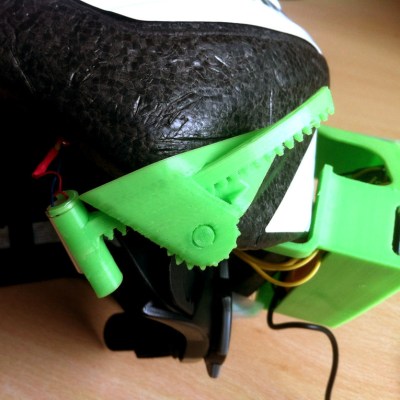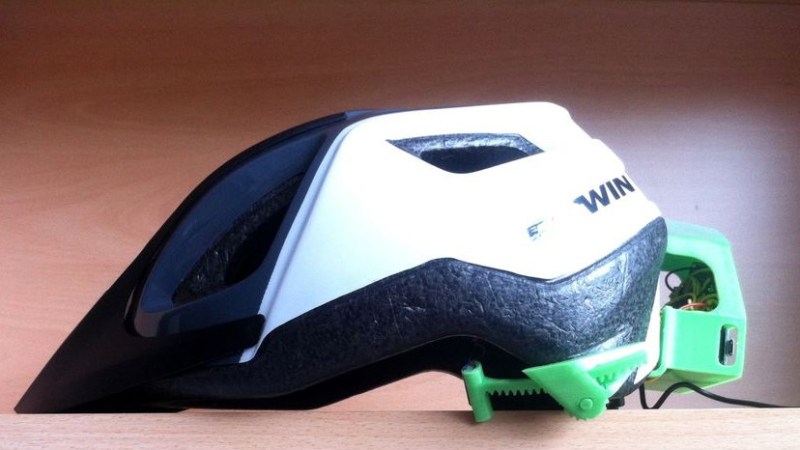[Matlek] had an interesting problem. On one hand, a 40 minute bike commute without music is a dull event but in France it is illegal for any driver to wear headphones. What to do? Wanting neither to break the law nor accept the risk of blocking out surrounding sounds by wearing headphones anyway, and unwilling to create noise pollution for others with a speaker system, [Matlek] decided to improvise a custom attachment for a bike helmet that plays audio via bone conduction. We’ll admit that our first thought was a worrisome idea of sandwiching metal surface transducers between a helmet and one’s skull (and being one crash away from the helmet embedding said transducers…) but happily [Matlek]’s creation is nothing of the sort.

The bone conduction is cleverly achieved by driving small DC motors with an audio signal through a TPA2012 based audio amplifier, which is powered by a single 18650 cell. By using motors in place of speakers, and using a 3D printed enclosure to hold the motors up to a sweet spot just behind the ears, it’s possible to play music that only the wearer can hear and does not block environmental sounds.
[Matlek] didn’t just throw this together, either. This design was the result of researching bone conduction audio, gathering a variety of different components to use as transducers, testing which performed best, and testing different locations on the body. Just behind the ear was the sweet spot, with the bony area having good accessibility to a helmet-mounted solution. Amusingly, due to the contact between the motors and the rest of the hardware, the helmet itself acts as a large (but weak) speaker and faint music is audible from close range. [Matlek] plans to isolate the motors from the rest of the assembly to prevent this.
Another good way to get audio to transmit via bone conduction? Send it through the teeth. While maybe not the best option for a bike rider, biting down on this metal rod sends audio straight to your inner ear.
















“[Matlek] had an interesting problem. On one hand, a 40 minute bike commute without music is a dull event but in France it is illegal for any driver to wear headphones. ”
I can see the wisdom in that law. Bicycling is already pretty dangerous when interacting with other motorized vehicles.
The point with bone conduction is that you still retain an awareness of your surroundings – you can still heart normally whilst listening to the music. Busy how well it works from that point of view is hard to appreciate if you have not tried it.
I used bone conduction headphones for about a year in a small shop and they worked great, I could hear the equipment and people in the room but my audio was also perfectly clear as well. I only stopped using them because the build quality was iffy and they started to split in a few places (tried 2 brands). If I could find a more robust pair I would go back to using them in a heartbeat.
Would be interesting to see the bone conduction thing used in combination with sensors for situational awareness instead of/in addition to entertainment.
Very cool project! I’ve solved this problem pretty simply by using a cheap Beofeng HAM radio as an FM boombox. It’s loud enough to hear myself, and has the added benefit of announcing my approach behind others.
I have have a magnetic implant in my skull to use a bone anchored hearing aid (BAHA), a processor w/ a transducer is held to my skull with a magnetic puck. The hearing aid really sucked and hated it enough that I gave it back to the company who made it in disgust.
But since I have this magnetic disc in my cranium already… why not use it?
Did some experimenting initially with transducers advertised for bone conduction but wasn’t overly impressed with what I had found. I do have a lot of hearing loss however and wanted something with a lot more output. Whilst looking for bigger bone conducting transducers, I discovered another wording for them: surface exciters. Advertised to turn walls, doors, cabinets and other surfaces into a speaker.
Being that I’ve been so deaf all my life, I never really gave any attention to anything relating to audio. Wasn’t sure what constituted the best for my purposes of hooking one straight up to my head and be small enough to be held there with the magnetic implant. Rather than read up a lot, I did the next best thing: throw money at it.
Bought a total of 36 different surface exciters, bought every one that was as light as the hearing aid the implant was intended for.
With a little 18650 powered 1.5W mono amplifier went about doing a taste-test. Trying out each one and creating a spreadsheet of which one I felt sounded the best, had good volume, etc.
Finally settled on which I liked the best. Cheap too, under $3. Works amazingly well.
I have a wire running to a headphone amplifier to boost the output and I use it while on the computer to listen to music. Which is nice, I don’t have to deafen the unborn to hear music anymore. Keep the noise to myself.
I also used another amplifier with a electret mic as a ghetto-hearing aid. Lil bulky cause I have to run a wire from it to my head. Causes some stares too. But works better than the $5k one I got from the hearing aid company. Don’t use it too much, as I said it is awkward to be stared at. But around the house I use it a lot.
Cool story, thanks for sharing. Probably worth a HAD writeup of its own.
I had never heard of the term “surface exciters”; thanks for sharing that! It’s amazing how many doors open up online once you search for the right magic words.
What is the name of the $3 exciter you found? Where did you source it?
Tectonic Elements TEAX14C02-8 14mm 2W Exciter @ parts-express.com
Apparently price is a bit higher today at $4.49, but anything cheaper than lunch these days is still a bargain.
Have you written this up anywhere? This would make a great Hackaday post. :)
Awesome! You can post your data somewhere that is free like a Github, Blogger or WordPress site and have an article written regarding. Would be interesting to see the details. My Mom is hearing impaired.
I just invested in the wired bone conducting headphones I’ve been eyeing for a while: https://www.ebay.com/itm/Running-Sport-Wired-Bone-Conduction-Stereo-Headset-Open-Ear-Headphone-Hands-free/142449929458
I figure with wires I can easily modify to be wireless if I want and comes with the control module. I didn’t realize has a microphone built in too. I haven’t verified the specification are true… though is producing lower tones than I expected with the test run to see how works after charging.
I used to bike with one headphone in. Then I decided that I’d do no one any harm by listening to music over a speaker.
You’d really be cool with a Ronco Mr Microphone™
Well, in case of some types of accidents any protrusions between helmet and head may be a problem?
What ever happened to those Sony phones that have a dime sized disc (speaker) that is held at right angle to the head and sits comfortably in the dip just aft of that little tab in in the center of the ear. They were tinny as hell but great for talk. There was no covering of the ear at all, not the slightest loss of hearing outside. Great when it’s hot!
Deaf people need have only an outside rear-view mirror to drive in my state. Mine is external to my head on my glasses. I enjoy full stereo and range and can hear the street till someone’s loud engine drowns my sound out, then I can’t hear. At this point I still have more hearing awareness than anyone in a glass fishbowl on wheels with the fan and the radio on. Wind noise is my biggest concern, I’d like much less.
If you’re a ham or first responder I hope those laws don’t apply, at least to one ear.
I don’t know how judgements work in France, but I could see some place like California giving you a ticket for a bone conduction system like this because the cop decided it was the same as headphones. Then you’d have to convince a judge that it’s not headphones.
(I think it is headphones, and you shouldn’t be allowed to use them)
It’s kinda bizarre how using headphones on a bicycle is illegal in a country where they have voiture sans permis. A car that doesn’t require you to have a license to drive on the road with everyone else. They’re kinda neat cars, however insane the concept is to me.
bone fones – great sound https://www.theatlantic.com/health/archive/2013/09/bone-fone-the-terror/279474/
This is something unique. I have not seen bike helmets that play music using motors. Was this experiment successful?